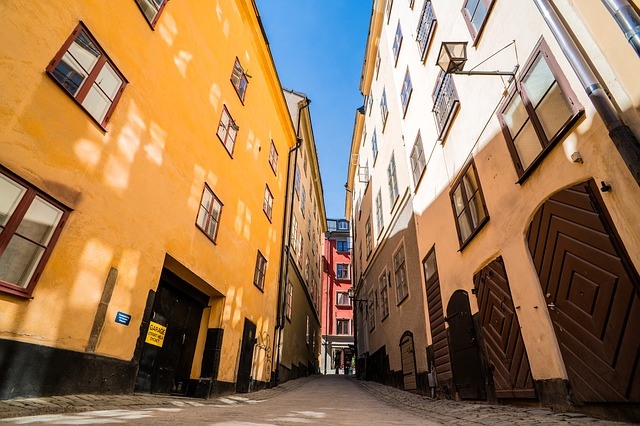Separated by over 400km, Gothenburg in the West of Sweden and Stockholm in the East are the two most populous cities in the country.
In many ways they share a similar culture and tradition and have many things in common; however, as with most cities they each have their own personalities with pros and cons to living in either.
We’ve put together a quick guide to the two locations in an effort to help you choose where to live in Sweden. For more information on the rest of Sweden, be sure to check out our complete Moving to Sweden guide.
Stockholm or Gothenburg: The Basics

Contemplating a move to Stockholm or Gothenburg?
Sweden itself ranks very highly on the global quality of life index in 12th position and the UK at 13th. Both Gothenburg and Stockholm also rank very highly. The only differences being in the levels of pollution being lower in Gothenburg but having a slightly longer traffic commute time.
The other major factor is in the cost of living including property prices and the cost of rental.
At a glance these are the basic stats comparing the two cities:
| Statistic | Gothenburg | Stockholm |
| Population | 545,000 | 926,000 |
| Size | 173 miles2 | 73 miles2 |
| Ave. Price of 3 Bed Apartment (Rent) | £1,121 | £1,710 |
| Ave. Price per sq.m (Buy) | £5,066 | £7,981 |
| Ave. Monthly Disposable Income | £1,933 | £2,087 |
On a similar latitude, both cities have reasonably temperate climates without the risk of the long, dark Swedish winters which loom over the North of the country.
Living in Gothenburg
Having the largest port of any Scandinavian city, Gothenburg is a hub for import and export activities for Sweden. However, it is the two sectors of manufacturing and industry upon which the city has predominantly based its wealth. In recent years banking and finance have become major players in the economy as well as high tech start-ups and small businesses. The city also relies on income from tourism and events.
The city is very multicultural and has an immigration population of around 18%; the largest groups of migrants are Somalian, Finnish, Polish and Iraqi.
With two universities there is a large number of domestic and international students living in Gothenburg and play a part in the diversity of the city’s demographic. The University of Gothenburg is one of Scandinavia’s largest institutes of higher learning and is ranked in the top 5% in the world being ranked at 247th in 2015.
Gothenburg is well connected with transport links including an international airport with direct routes across Europe as well as Mexico, the Dominican Republic and the ever popular winter getaway, Thailand. Its proximity to neighbouring Norway is also a bonus.
The city has a theme park right in the heart of the city which attracts families, students and tourists all year round. In fact, as a city for the younger generation, Gothenburg has plenty to offer including exciting nightlife, a thriving music scene and an abundance of summer festivals.
Gothenburg has a quirky nature to it with locations like the (not so) secret air base at the city airport which houses a history of the Swedes plans to defend against potential Soviet attacks during the Cold War. There is an independent cinema housed in a former school building which shows an eclectic mix of indie films.

Gothenburg: The city known as ‘Sweden’s largest village’
There is also a good market in Kvibergs which sells everything from interesting antiques and junk to cheap electronics. It’s a place where you can often find lots of students in the market for a bargain.
Known as Sweden’s largest village, the city has a more relaxed feel to it than Stockholm and with less inhabitants in a larger space it doesn’t feel crowded.
Living in Stockholm
The economy of the capital city is built almost entirely around the service industry, representing 85% of the city’s wealth. It is partly this reason which contributes to Stockholm being one of Europe’s cleanest air cities – no heavy industry.
Tourism is also a major sector and the Stockholm area accommodates over 10 million business stays each year making the capital the 10th largest visitor destination in Europe.
When it comes to culture, Stockholm is better serviced and is crowded with museums; one of the most densely packed cities in the world for such attractions. There are plenty of other ways to discover Swedish traditions and history including through its fine architecture, literary heritage and art galleries.
As a city where tourism is abundant and business vital the pace of life and work is fast and you get the real sense that you are in a big city. This can be reflected in the nightlife and bustling energy of its university students.
However, Stockholm also has its quieter side and the suburbs are a very popular place to live even if the commute is that much longer.

The old city of Stockholm: a popular sightseeing spot
Stockholm’s international airport flies direct to more places than Gothenburg but is also a well connected hub for people flying in and out of the country, across Europe and beyond.
Overall, the differences between the cities are less than the similarities they share but if we were to give you a comparison the East/West divide would be like choosing between a city in the North of England such as Newcastle vs a city in the South of the UK like London. Both beautiful, both quintessentially Swedish, the choice will be down to personal taste.
Stockholm vs Gothenburg: Which is the best city for expats?
Let us know your thoughts below!




